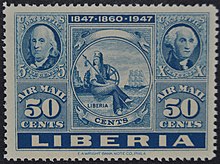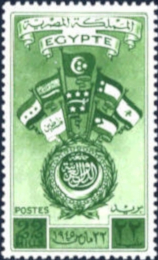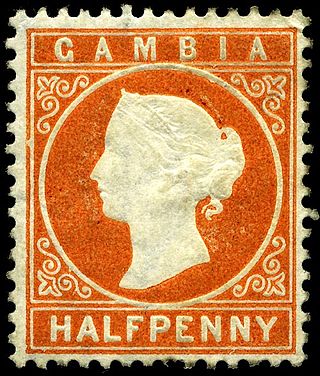
This is a survey of the postage stamps and postal history of Liberia .
Contents
Liberia is a country on the west coast of Africa, bordered by Sierra Leone, Guinea, Côte d'Ivoire, and the Atlantic Ocean. The capital is Monrovia.

This is a survey of the postage stamps and postal history of Liberia .
Liberia is a country on the west coast of Africa, bordered by Sierra Leone, Guinea, Côte d'Ivoire, and the Atlantic Ocean. The capital is Monrovia.

Began as a settlement of the American Colonization Society (ACS), Liberia declared its independence on July 26, 1847. The first stamps of Liberia were issued in 1860, depicting a sitting Liberty with a sailing vessel in the background. [1] [2]



Philately is the study of postage stamps and postal history. It also refers to the collection and appreciation of stamps and other philatelic products. While closely associated with stamp collecting and the study of postage, it is possible to be a philatelist without owning any stamps. For instance, the stamps being studied may be very rare or reside only in museums.

A postage stamp is a small piece of paper issued by a post office, postal administration, or other authorized vendors to customers who pay postage. Then the stamp is affixed to the face or address-side of any item of mail—an envelope or other postal cover —which they wish to send. The item is then processed by the postal system, where a postmark or cancellation mark—in modern usage indicating date and point of origin of mailing—is applied to the stamp and its left and right sides to prevent its reuse. Next the item is delivered to its addressee.

A piece of postal stationery is a stationery item, such as a stamped envelope, letter sheet, postal card, lettercard, aerogram or wrapper, with an imprinted stamp or inscription indicating that a specific rate of postage or related service has been prepaid. It does not, however, include any postcard without a pre-printed stamp, and it is different from freepost for preprinted cards issued by businesses. In general, postal stationery is handled similarly to postage stamps; sold from post offices either at the face value of the printed postage or, more likely, with a surcharge to cover the additional cost of the stationery. It can take the form of an official mail issue produced only for the use of government departments.

Postal service in the United States began with the delivery of stampless letters whose cost was borne by the receiving person, later encompassed pre-paid letters carried by private mail carriers and provisional post offices, and culminated in a system of universal prepayment that required all letters to bear nationally issued adhesive postage stamps.

Postal history is the study of postal systems and how they operate and, or, the study of the use of postage stamps and covers and associated postal artifacts illustrating historical episodes in the development of postal systems. The term is attributed to Robson Lowe, a professional philatelist, stamp dealer and stamp auctioneer, who made the first organised study of the subject in the 1930s and described philatelists as "students of science", but postal historians as "students of humanity". More precisely, philatelists describe postal history as the study of rates, routes, markings, and means.

The British post offices in Morocco, also known as the "Morocco Agencies", were a system of post offices operated by Gibraltar and later the United Kingdom in Morocco.

The postage stamps and postal history of Israel is a survey of the postage stamps issued by the state of Israel, and its postal history, since independence was proclaimed on May 14, 1948. The first postage stamps were issued two days later on May 16, 1948. Pre-1948 postal history is discussed in postage stamps and postal history of Palestine.

The Inter-Governmental Philatelic Corporation, or IGPC, is a philatelic agency that represents over 70 different countries in the design, production, and marketing of postage stamps. It also assists postal administrations with the running of their postal services. IGPC claim to produce nearly half of the different postage stamps issued each year but have been criticized for inappropriate and excessive issues.

This is an article about the postage stamps and postal history of the Sovereign Military Order of Malta.

This is a survey of the postage stamps and postal history of Ghana, known as the Gold Coast before independence.
This is a survey of the postage stamps and postal history of the Democratic Republic of the Congo, formerly Zaire and the Belgian Congo.

This is a survey of the postage stamps and postal history of Egypt.

This is a survey of the postage stamps and postal history of Sierra Leone.

This is a survey of the postage stamps and postal history of Equatorial Guinea, formerly known as Spanish Guinea.
This is a survey of the postage stamps and postal history of Eritrea.

This is a survey of the postage stamps and postal history of the Republic of the Congo, a former French colony known as Middle Congo or French Congo, and now often known simply as The Congo.

This is a survey of the postage stamps and postal history of Guinea.

The following is a survey of the postage stamps and postal history of Somalia. From the late 1800s to 1960, northwestern present-day Somalia was administered as British Somaliland, while the northeastern, central and southern part of the country were concurrently administered as Italian Somaliland. In 1960, the two territories were unified as the Somali Republic.
This is a survey of the postage stamps and postal history of Madagascar, briefly also known as Malagasy.

This is a survey of the postage stamps and postal history of the Gambia.